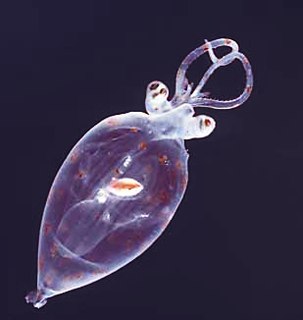
The blue whale is a marine mammal and a baleen whale. Reaching a maximum confirmed length of 29.9 meters (98 ft) and weighing up to 199 tonnes, it is the largest animal known to have ever existed. The blue whale's long and slender body can be of various shades of greyish-blue dorsally and somewhat lighter underneath. Four subspecies are recognized: B. m. musculus in the North Atlantic and North Pacific, B. m. intermedia in the Southern Ocean, B. m. brevicauda in the Indian Ocean and South Pacific Ocean, B. m. indica in the Northern Indian Ocean. There is also a population in the waters off Chile that may constitute a fifth subspecies.

An ecoregion or ecozone is an ecologically and geographically defined area that is smaller than a bioregion, which in turn is smaller than a biogeographic realm. Ecoregions cover relatively large areas of land or water, and contain characteristic, geographically distinct assemblages of natural communities and species. The biodiversity of flora, fauna and ecosystems that characterise an ecoregion tends to be distinct from that of other ecoregions. In theory, biodiversity or conservation ecoregions are relatively large areas of land or water where the probability of encountering different species and communities at any given point remains relatively constant, within an acceptable range of variation.

Sea slug is a common name for some marine invertebrates with varying levels of resemblance to terrestrial slugs. Most creatures known as sea slugs are gastropods, i.e. they are sea snails that over evolutionary time have either completely lost their shells, or have seemingly lost their shells due to having a greatly reduced or internal shell. The name "sea slug" is most often applied to nudibranchs, as well as to a paraphyletic set of other marine gastropods without obvious shells.

Decapodiformes is a superorder of Cephalopoda comprising all cephalopod species with ten limbs, specifically eight short arms and two long tentacles. It is hypothesized that the ancestral coleoid had five identical pairs of limbs, and that one branch of descendants evolved a modified arm pair IV to become the Decapodiformes, while another branch of descendants evolved and then eventually lost its arm pair II, becoming the Octopodiformes.
The World Register of Marine Species (WoRMS) is a taxonomic database that aims to provide an authoritative and comprehensive list of names of marine organisms.

Vanikoroidea is a superfamily of sea snails, marine gastropod molluscs in the clade Littorinimorpha. The superfamily Eulimoidea is a synonym of Vanikoroidea.

The Harpidae, known as the harp snails, are the members of a taxonomic family of large predatory sea snails, marine gastropod mollusks.

Freshwater snails are gastropod mollusks which live in fresh water. There are many different families. They are found throughout the world in various habitats, ranging from ephemeral pools to the largest lakes, and from small seeps and springs to major rivers. The great majority of freshwater gastropods have a shell, with very few exceptions. Some groups of snails that live in freshwater respire using gills, whereas other groups need to reach the surface to breathe air. In addition, some are amphibious and have both gills and a lung. Most feed on algae, but many are detritivores and some are filter feeders.
Austroharpa exquisita is a species of sea snail, a marine gastropod mollusk in the family Harpidae, the harp snails.
Austroharpa learorum is a species of sea snail, a marine gastropod mollusk in the family Harpidae, the harp snails.
Austroharpa loisae is a species of sea snail, a marine gastropod mollusk in the family Harpidae, the harp snails.
Austroharpa punctata is a species of sea snail, a marine gastropod mollusk in the family Harpidae, the harp snails.
Austroharpa wilsoni is a species of sea snail, a marine gastropod mollusk in the family Harpidae, the harp snails.
Austroharpa is a genus of sea snails, marine gastropod mollusks in the family Harpidae.

Neritina pulligera, common name the dusky nerite, is a species of freshwater snail, a gastropod mollusk in the family Neritidae.

Austrosassia is a genus of sea snails, a marine gastropod mollusc in the family Cymatiidae.
Austroharpa tatei is an extinct species of sea snail, a marine gastropod mollusk, in the family Harpidae.
Harpinae is a subfamily of sea snails within the family Harpidae.








